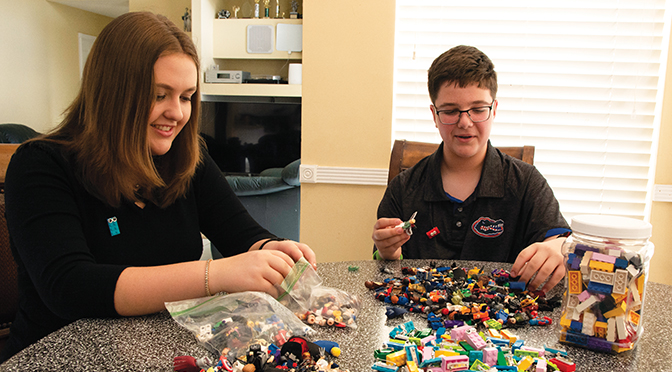While many younger sisters might not want to follow in their brother’s footsteps, Wellington High School junior Sarah Clein relishes the job of taking over the responsibility of the local nonprofit Bricks Busting Boredom founded by her sibling Daniel Clein.
To date, the nonprofit has redistributed more than 2,500 pounds of Lego bricks and given away hundreds of new sets to seriously ill children.
Sarah, not yet driving, nonetheless manages to provide public relations for the project and goes with her mother, Deborah Clein, all over the county collecting Legos and then delivering them to children in hospitals and shelters.
Since 2017, when Daniel headed off to college, she has organized Lego parties, where younger brother Jonathan Clein, 13 and heir to the organization, helps out and is known to dress as a Lego man to distribute the famous toys to children.
“My mother and I work together to do public relations and all the footwork to pick up Legos,” Sarah said. “We try and get the word out so that people who have Legos know to bring them to the many different drop-off locations we have set up around the county.”
Even people who have not had children are likely familiar with the world-famous Lego brand of little plastic bricks that can be connected to assemble objects such as buildings, vehicles, even working robots, then disassembled and the pieces used to make something else.
They are immensely popular with children worldwide and are so ubiquitous that marketing experts have named them Brand Finance’s “World’s Most Powerful Brand.” Lego bricks are durable, don’t wear out easily with repeated coupling and disassembly, and can be sanitized for new users.
Patented in 1958, the modern Lego brick design has roots in the woodworking facility of a Danish carpenter. Invented in the workshop of Oleg Kirk Christiansen, Legos evolved in the 1930s and 1940s from wooden toys, becoming what we would recognize as modern Legos in 1949. The toys earned their name based upon the first two letters of the words leg godt, which means “play well” in Danish.
During the ensuing decades, many have noticed how involved children and adults can become building with the tiny bricks. Sarah noted that working with them has a therapeutic effect.
“It allows kids to really let their imaginations run wild,” she explained. “I see kids sit down, and they have a bunch of Legos, they’re playing with them and they already have a plan in their heads. They make cars and buildings. They make things I never would have thought of. The kids will sit there for hours; you see them, their mind is working, their eyes light up. It distracts them from everything else that is going on in their lives. It’s adorable.”
Bricks Busting Boredom has grown rapidly since Daniel started it in 2015 after visiting his cousin in the hospital and learning of how useful Lego bricks and Lego sets can be for young patients. “We have fundraisers and accept donations to buy new Lego sets,” Deborah said. “Some hospitals will only let us donate new, unopened toys in the box.”
A safety precaution, perhaps, but Legos can be thoroughly cleaned and passed down. They are virtually indestructible, as any parent knows who has ever stepped on an errant brick. How indestructible? The company reports it would take 950 pounds of force to crush a single brick. That equates to being at the bottom of a tower 375,000 bricks high.
With approximately 180 bricks to the pound, a recent trip this summer to New York delivered 400 pounds to severely ill children at Camp Simcha.
“We heard about a camp for sick kids that had a Lego room,” Sarah said. “It was all decorated for playing with Legos with nicely painted walls and a good floor surface. It just needed Legos, so a volunteer drove our donation of 400 pounds of Legos up in a truck and delivered them to the camp.”
Begun as a project by Daniel, Sarah took over two years later and Jonathan is set to take over when she graduates. The consistent factor through the various siblings’ tenure has been Deborah, who provides tireless support to her children.
“We provide sets to children’s hospitals like Palm Beach, Palms West and Joe DiMaggio, as well as Quantum House,” she said. “Everyone we interact with gets a set of Legos that they can take home with them.”
Once focused on Palm Beach County, the nonprofit is growing.
“We are currently working with Kindness Matters 365,” Sarah said. “We’re picking up at different schools around Florida, and we have plans to continue to grow outside of Florida.”
In the future, they may even have support from the company itself.
“Recently, we found out that the Lego company has started a Lego Replay program, collecting used Legos, cleaning them and sending them to different organizations,” Sarah said. “We asked to be part of the program, and they said right now they’re just getting on their feet with it, but they will consider us in the future. We would love to work with the Lego company.”
In other future plans, she also wants to donate to more hospitals in and around Florida, along with women’s shelters and homeless shelters. “Anywhere we see a need for Legos, we want those people to be able to have the opportunity to use the Legos,” Sarah said.
Of course, the entire program runs on donations.
“I just want to let people know if they have Legos, please donate them, and we will put them in the hands of kids who can really use them,” Sarah said.
For information about Bricks Busting Boredom, including how to donate, call (954) 682-3816 or visit www.bricksbustingboredom.org. To see the group in action, visit www.facebook.com/BricksBustingBoredom.
